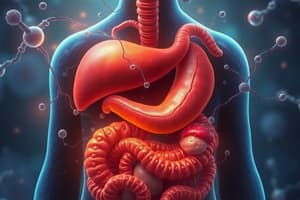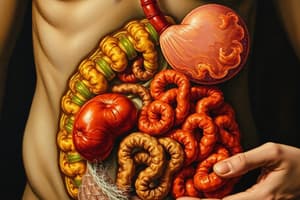Podcast
Questions and Answers
What is the primary function of stomata in plants?
What is the primary function of stomata in plants?
- Gas exchange between the plant and the atmosphere (correct)
- Photosynthesis in chloroplasts
- Protection against herbivores
- Water transport within the plant
In which part of the chloroplast do the light-dependent reactions occur?
In which part of the chloroplast do the light-dependent reactions occur?
- Outer membrane
- Inner membrane
- Stroma
- Thylakoid membranes (correct)
What type of light do plants primarily absorb for photosynthesis?
What type of light do plants primarily absorb for photosynthesis?
- Infrared light
- Green light
- Blue and red light (correct)
- Yellow light
What is the outcome of the light-independent reactions known as the Calvin Cycle?
What is the outcome of the light-independent reactions known as the Calvin Cycle?
How does the structure of stomata change in dry environments?
How does the structure of stomata change in dry environments?
What is the primary function of the small intestine in digestion?
What is the primary function of the small intestine in digestion?
Which enzyme is responsible for breaking down fats in the small intestine?
Which enzyme is responsible for breaking down fats in the small intestine?
Which organ produces bile that aids in fat digestion?
Which organ produces bile that aids in fat digestion?
What process occurs in the large intestine regarding indigestible food matter?
What process occurs in the large intestine regarding indigestible food matter?
In which part of the digestive system is protease active for protein digestion?
In which part of the digestive system is protease active for protein digestion?
How does body position affect pill absorption?
How does body position affect pill absorption?
Which substance is not digested by human enzymes but aids in digestion?
Which substance is not digested by human enzymes but aids in digestion?
Which enzyme breaks down lactose into glucose and galactose?
Which enzyme breaks down lactose into glucose and galactose?
Flashcards
Photosynthesis Equation
Photosynthesis Equation
6 Carbon Dioxide + 6 Water + Sunlight → Glucose + 6 Oxygen
Light-Dependent Reactions
Light-Dependent Reactions
Reactions in chloroplasts that use sunlight to create ATP and NADPH.
Light-Independent Reactions
Light-Independent Reactions
Reactions in chloroplasts that use ATP and NADPH to produce glucose.
Chloroplast Structure
Chloroplast Structure
Signup and view all the flashcards
Stomata Function
Stomata Function
Signup and view all the flashcards
Role of the Mouth in Digestion
Role of the Mouth in Digestion
Signup and view all the flashcards
Stomach's Role in Digestion
Stomach's Role in Digestion
Signup and view all the flashcards
Small Intestine Digestion
Small Intestine Digestion
Signup and view all the flashcards
Amylase's Function
Amylase's Function
Signup and view all the flashcards
Protease Digestion
Protease Digestion
Signup and view all the flashcards
Lipase Function
Lipase Function
Signup and view all the flashcards
Large Intestine Function
Large Intestine Function
Signup and view all the flashcards
Bile's Role in Digestion
Bile's Role in Digestion
Signup and view all the flashcards
Study Notes
Digestive System
- The mouth mechanically breaks down food through chewing (chewing) and chemically through saliva containing amylase.
- The stomach produces gastric juices, containing acids and enzymes, like pepsin. It churns food into chyme.
- The small intestine is the primary site for digestion and absorption.
- Enzymes (amylase, protease, lipase) break down carbohydrates, proteins, and lipids respectively.
- Nutrients absorb into bloodstream through villi.
- The large intestine absorbs water and electrolytes from the remaining food and forms feces.
- The pancreas produces digestive enzymes (amylase, lipase, protease) and bicarbonate to neutralize stomach acid.
- The liver produces bile that emulsifies fats aiding digestion in the small intestine.
- The gallbladder stores bile.
- The rectum and anus store and expel waste.
Enzymes Involved in Digestion
- Amylase breaks down starch into sugars (in mouth and small intestine).
- Protease (e.g., pepsin) breaks down proteins to amino acids (active in stomach).
- Lipase breaks down lipids (fats) to fatty acids and glycerol (in small intestine).
- Lactase breaks down lactose into glucose and galactose (in small intestine).
- Nuclease breaks down nucleic acids to nucleotides.
Digestion of Different Molecules
- Carbohydrates are broken down into monosaccharides (e.g. glucose) by amylase (mouth) and other enzymes (small intestine).
- Cellulose/fiber is not digested by human enzymes, increasing stool bulk and facilitating peristalsis.
- Proteins are broken down into amino acids by proteases (stomach - pepsin, small intestine - trypsin and chymotrypsin).
- Lipids are broken down into fatty acids and glycerol by lipase (small intestine).
Body Position and Pill Intake
- Body position affects pill absorption. Swallowing upright ensures efficient passage through the esophagus and stomach.
Proteases in Digestion (Lab Review)
- Proteases are protein-digesting enzymes.
- Stomach samples are likely to contain proteases.
- Protease activity can be measured by protein breakdown indicators (like biuret solution).
Photosynthesis
Leaf Structure and Function
- Cuticle reduces water loss.
- Epidermis is a protective outer layer.
- Stomata are pores for gas exchange.
- Mesophyll contains chloroplasts for photosynthesis.
- Xylem and phloem transport water/nutrients and sugars respectively.
Stomata Adaptations
- Dry environments have fewer/smaller stomata to reduce water loss.
- Wet environments have more stomata for better gas exchange.
Light Absorption
- Plants primarily absorb blue (430-450nm) and red light (640-680nm).
- Green light is reflected making plants appear green.
Photosynthesis Equation
- 6CO₂ + 6H₂O + sunlight → C₆H₁₂O₆ + 6O₂
Light-Dependent and Light-Independent Reactions
- Light-dependent reactions occur in thylakoid membranes using light energy to convert water to oxygen, ATP, and NADPH
- Light-independent reactions (Calvin Cycle) occur in the stroma. Using ATP and NADPH from light-dependent reactions to convert CO₂ into glucose.
Chloroplast Structure
- Outer membrane encloses the chloroplast.
- Inner membrane surrounds the stroma.
- Thylakoids are sacs where light-dependent reactions happen.
- Stroma is the fluid where the Calvin cycle occurs.
Studying That Suits You
Use AI to generate personalized quizzes and flashcards to suit your learning preferences.




